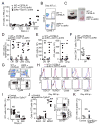Truncated form of TGF-βRII, but not its absence, induces memory CD8+ T cell expansion and lymphoproliferative disorder in mice
- PMID: 23686479
- PMCID: PMC3690649
- DOI: 10.4049/jimmunol.1300397
Truncated form of TGF-βRII, but not its absence, induces memory CD8+ T cell expansion and lymphoproliferative disorder in mice
Abstract
Inflammatory and anti-inflammatory cytokines play an important role in the generation of effector and memory CD8(+) T cells. We used two different models, transgenic expression of truncated (dominant negative) form of TGF-βRII (dnTGFβRII) and Cre-mediated deletion of the floxed TGF-βRII to examine the role of TGF-β signaling in the formation, function, and homeostatic proliferation of memory CD8(+) T cells. Blocking TGF-β signaling in effector CD8(+) T cells using both of these models demonstrated a role for TGF-β in regulating the number of short-lived effector cells but did not alter memory CD8(+) T cell formation and their function upon Listeria monocytogenes infection in mice. Interestingly, however, a massive lymphoproliferative disorder and cellular transformation were observed in Ag-experienced and homeostatically generated memory CD8(+) T cells only in cells that express the dnTGFβRII and not in cells with a complete deletion of TGF-βRII. Furthermore, the development of transformed memory CD8(+) T cells expressing dnTGFβRII was IL-7- and IL-15-independent, and MHC class I was not required for their proliferation. We show that transgenic expression of the dnTGFβRII, rather than the absence of TGF-βRII-mediated signaling, is responsible for dysregulated expansion of memory CD8(+) T cells. This study uncovers a previously unrecognized dominant function of the dnTGFβRII in CD8(+) T cell proliferation and cellular transformation, which is caused by a mechanism that is different from the absence of TGF-β signaling. These results should be considered during both basic and translational studies where there is a desire to block TGF-β signaling in CD8(+) T cells.
Conflict of interest statement
The authors declare no competing financial interests.
Figures








References
Publication types
MeSH terms
Substances
Grants and funding
LinkOut - more resources
Full Text Sources
Other Literature Sources
Molecular Biology Databases
Research Materials

